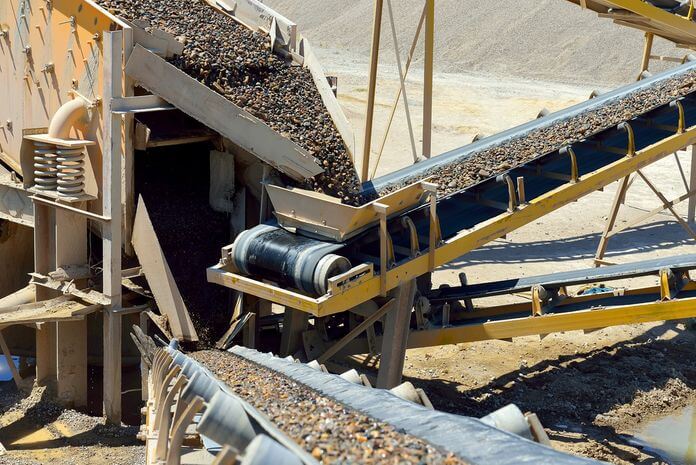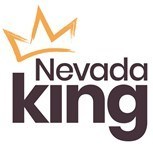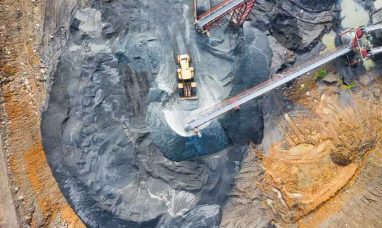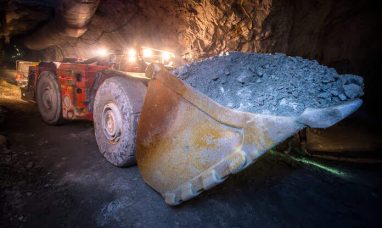NEVADA KING INTERSECTS SIGNATURE ALTERATION SUITE MINERALS & ROCKS FROM DEEP CORE DRILLING PROGRAM TARGETING LOWER PLATE HOSTED GOLD AT IRON POINT PROJECT, BATTLE MOUNTAIN TREND, NEVADA
Canada NewsWire
VANCOUVER, BC
,
July 13, 2022
/CNW/ –
Nevada King Gold Corp.
(TSX-V: NKG) (OTCQX: NKGFF) (”
Nevada King
” or the ”
Company
“) is pleased to provide an update on the deep drilling campaign at the Company’s 100% owned Iron Point Gold Project (”
Iron Point
” or the ”
Project
“) in
Humboldt County, Nevada
. Two diamond drill core holes planned for the 2022 drill program targeting Lower Plate hosted gold have been completed and drilling of the third core hole is currently underway. Iron Point is located at the juncture between the prolific Getchell and
Battle Mountain
gold trends and represents a district-scale
Carlin
-type gold exploration target.
Deep Drill Program Highlights
- In
January 2022
,
Nevada King
commenced pre-collar drilling for a
4,000m
, deep drill program at Iron Point to further test
Carlin
-type gold mineralization hosted in Lower Plate carbonate rocks beneath the Roberts Mountain Thrust and below a large gold and pathfinder element anomaly in the Upper Plate defined by more than ten drill campaigns over several decades targeting the Upper Plate. - The current program is designed to follow up on initial drilling completed in 2019 by the Company in which a thick sequence of Lower Plate carbonate rocks was encountered in core hole VM-008C. This hole bottomed in strongly anomalous gold mineralization and associated pathfinder elements, intercepting
5.8m
grading 0.17 g/t Au. - The diamond drill core tails on the first two holes along the RFZ (Range Front Zone), IP22-004 and IP22-005, have been completed to depths of
916.8m
and
932.7m
, respectively. Drilling of a third diamond drill core tail is underway at IP22-001 in the Fairway Zone and is currently at
760m
depth. - All three 2022 drill holes have successfully intersected the Lower Plate carbonate section, as well as alteration styles typically associated with
Carlin
-type gold deposits.
Project Background
The Iron Point Gold Project is located 35km east of
Winnemucca, Nevada
, at the intersection of the
Battle Mountain
and Getchell gold belts, and on trend from several world-class gold mines including Twin Creeks and Turquoise Ridge with a combined gold endowment of 52 Moz Au (Barrick 2020 Annual Report, and Nevada Division of Minerals Feature Layer “Production of Minerals in
Nevada
1987-Present” updated
Oct. 22, 2021
), and
Marigold and Lone Tree
with a reported gold endowment of 20 Moz (I-80 Gold Corp NI 43-101 Technical Report on
Lone Tree Mine
, and SSR Mining 2020 Annual Report, and Nevada Division of Minerals Feature Layer “Production of Minerals in
Nevada
1987-Present” updated
Oct. 22, 2021
).
In the Iron Point area, Upper Plate Ordovician Vinini Formation overlies interpreted Lower Plate silty carbonates, separated by the shallowly west-dipping Roberts Mountain thrust fault. Younger north-south striking range front faults bounding the Iron Point Mining District’s eastern margin cut the Upper and Lower Plate sequences, forming a down-dropped graben east of the range front that was subsequently covered by thick alluvium.
Since the mid-1960s, the Iron Point district and surrounding area have been explored by numerous companies for different commodities, including gold and vanadium, beginning with Newmont in 1966 and continuing to
Miranda Gold
in 2008. Exploration efforts focused almost exclusively on shallow, Upper Plate hosted gold targets (<
300m
depths). Whereas, deeper potential for a
Carlin
-type gold deposit in Lower Plate rocks beneath the Roberts Mountain thrust remains virtually untested.
Some of the strongest
Carlin
-type gold pathfinder element geochemistry anomalism known in
Nevada
occurs at Iron Point along a north-trending zone 5 km long that is also anomalous in gold. Historic drilling encountered multiple intervals of significantly anomalous gold mineralization in Upper Plate stratigraphy. A small number of historical holes testing shallow Lower Plate stratigraphy exposed in the northern part of the property within an erosional window beneath the Roberts Mountain thrust also returned significantly anomalous pathfinder values, including an interval of
Carlin
-type gold mineralization. The Company’s 2019 drilling which tested these Lower Plate rocks encountered an interpreted recumbent Zed-fold that is partially exposed along the range front fault. A similar geologic setting including recumbent Zed-folding along a range front fault approximately 40km northeast of Iron Point is host to extensive gold-mineralization at Newmont’s Twin Creeks mine and partly based on this model. However, within the property’s southern portion, only
Nevada King’s
deep core hole VM-008C has to date encountered
Carlin
-type mineralization in rocks conclusively identified as Lower Plate.
Range Front Zone (“RFZ”) Deep Drill Program
Three of the four pre-collars are located close to a deep structural break striking north-south (the ”
Range Front Zone
” or ”
RFZ
“) along the eastern margin of Iron Point mining district. As shown in Figure 2, the mineralized interval in Lower Plate stratigraphy encountered near the bottom of core hole VM-008C occurs on the west side (upthrown side) of the RFZ, while the three pre-collar holes are located on the east side within the down-thrown block. A ground-based gravity survey completed in 2020 provided higher resolution definition of the RFZ and indicated the down-thrown eastern block extends up to 3.5km eastward from the RFZ. If favourable Lower Plate carbonates are intersected in this down-dropped block, the target area along and east of the RFZ will be greatly expanded. The three scout holes in this area are designed to step-out eastwardly from intervals of Lower Plate hosted gold and pathfinder mineralization intercepted in hole VM-008C and test the down-dropped fault block on the hanging wall (east) side of the RFZ.
As noted, VM-008C bottomed in
5.8m
grading 0.17g/t Au accompanied by elevated As, Sb, and Hg in silicified Lower Plate thin-bedded “dirty” limestone sequences, similar in appearance to the Roberts Mountain Formation, which remains an historic host to high-grade gold deposits on the Carlin Trend. IP22-004 is located approximately
90m
northwest of historic hole CH-IP88-03 drilled by Chevron Minerals in 1988 which intersected
7.62m
grading 1.59 g/t Au beginning
353.57m
downhole, including
1.54m
grading 3.68 g/t Au at
355m
.
IP22-004 was pre-collared and cased to a depth of
332m
, and a core tail extended the hole to a total depth of
916.8m
. The pre-collar encountered
128m
of alluvial gravels before penetrating bedrock, then drilled a quartzite dominated Upper Plate sequence to
308m
depth. Difficult ground conditions between 308-
332m
depth prevented recovery of drill cuttings; it is within this interval that the interpreted Roberts Mountain thrust was crossed. The core tail began in a thick sequence of Lower Plate limestone that had been altered to calc-silicate hornfels and marble to a depth of
475m
. Two intrusive dikes of intermediate to mafic composition cut the section from 483.4-
490.1m
and 518.2-
519m
; these typically occupy structural zones in nearby drill holes. The limestone section bracketed by the dikes has been sheared, brecciated, and strongly altered, exhibiting decalcification and silicification as well as strong calcite-quartz +/- pyrite veining. The alteration is centred around the lower intrusive, with additional calc-silicate hornfels/marble intervals from 519-
536m
and 547.6-
568m
. The section from 536-
625m
is a thin bedded bioturbated silty limestone, below which lithology is dominantly micritic limestone to variably calcareous mudstone. A large interval from 653.5-
738m
exhibits multiple structural zones with shears, folds, and brecciation accompanied by moderate decalcification and silicification, and strong calcite-quartz veining. Below
792m
, bedding is relatively undisturbed with shallow dips, and weak local decalcification and silicification.
All samples for IP22-004 have been submitted to ALS Global laboratory in
Elko, Nevada
, and assays are pending.
Recently completed RFZ drill hole IP22-005, situated
600m
to the NNE of drill hole VM-008C, is a
265m
step-out of mineralization encountered in 2019 drill hole EG-001C. Grade-thickness contours of nearby historic drill holes indicate an ENE orientation to Au mineralization in the Upper Plate siliciclastic rocks, thus forming a vector that coincides with a pronounced shoulder in the gravity dataset. EG-001C intersected the following zones of low-grade gold mineralization:
25.9m
grading 0.198 g/t Au from 22.9-
48.8m
downhole associated with brecciated quartzite, strong sulfide veining, and intrusive dikes
10.7m
grading 0.303 g/t Au and 50.4 g/t Ag, from 172.2-
182.9m
downhole hosted in quartzite with intrusive dikes, breccia, and quartz-sulfide veining
18.3m
grading 0.309 g/t Au from 358.1-
376.4m
downhole hosted in granodiorite and endoskarn
IP22-005 was pre-collared and cased to a depth of
322.8m
, and a core tail extended the hole to a total depth of
932.7m
. A sequence of alluvial gravels and Upper Plate quartzite was drilled in the pre-collar. In the core tail, the quartzite section continued to a depth of
432m
depth and was cut by a number of intrusive dikes, as well as a zone of thick red-brown fault gouge from 327.8-
339.2m
. Granodiorite bodies extend from 432-
501m
and 546.8-
667.8m
, with the intervening zone being dominantly skarnoid or biotite hornfels. A steeply-dipping sheared contact at
667.8m
with fault gouge, milled clasts and local hydrothermal breccias separates the granodiorite above from the Lower Plate carbonate section below. The structural zone extends to
755.6m
, with additional zones of brecciated, sheared, and folded beds present from 775.2-
778.8m
, 788.4-
791.4m
, 802.5-
856m
and 892.6-
926m
. Alteration is variable with weak to moderate decalcification and silicification. Overall, the bedding is steeply dipping and lithology is dominantly micritic limestone. The interval from 906.2-
932.7m
has been recrystallized to a sparry limestone, with local marble intervals centred around an injection dike of intermediate to mafic composition at 919.3-
920m
with milled intrusive clasts and subangular to subrounded limestone fragments.
All samples for IP22-005 have been submitted to ALS Global laboratory in
Elko, Nevada
, and assays are pending.
Fairway Zone Deep Drill Program
During 2021,
Nevada King’s
geologists compiled and integrated extensive datasets including new (2020), separate geophysical surveys for Bouguer gravity, resistivity (CSAMT), and aeromagnetics, along with historic soil and drill results, resulting in identification of a profound NNW-trending structural corridor, referred to as the “Fairway Zone” (Figure 2). This zone displays alteration and gold mineralization centered along an interpreted intrusive complex which extends over a distance of 4.5km, projecting under the post-mineral basalt flows to the north. Prospective Lower Plate stratigraphy is expected to be encountered in this area.
Drill hole IP22-001, collared 2.2km NNW of VM-008C, is the initial test of this target area. The pre-collar has been drilled and cased to a depth of
245m
. Drilling of the diamond core tail is presently underway; bit depth is
760m
at this time, and the planned total depth for the drill hole is approximately
915m
. Multiple zones of quartz veining, decalcification, and silicification have been encountered in the pre-collar and core tail indicating the presence of a hydrothermal system.
Sampling Methodology and QA/QC Procedures
All Project diamond drill core samples are logged, cut and sampled at Nevada King’s processing facility in
Winnemucca, Nevada
, under supervision of the Company’s geologists. Chain of custody is maintained throughout the process from the Project area to the ALS Global laboratory in
Elko, Nevada
. Au is analyzed by fire assay with AA finish, overlimit samples are assayed by fire assay with gravimetric finish. Multielements are analyzed by ICP-AES following four-acid digestion.
Nevada King
inserts CRM pulp standards and coarse blank samples into the sample stream at a regular interval rate of one per twenty samples.
Qualified Person
The scientific and technical information in this news release has been reviewed and approved by
Calvin R. Herron
, P.Geo., who is a Qualified Person as defined by National Instrument 43-101 (”
NI 43-101
“).
About Nevada King Gold Corp.
Nevada King
is the third largest mineral claim holder in the
State of Nevada
, behind
Nevada Gold Mines
(Barrick/Newmont) and
Kinross Gold
. Starting in 2016 the Company has staked large project areas hosting significant historical exploration work along the
Battle Mountain
trend located close to current or former producing gold mines. These project areas were initially targeted based on their potential for hosting multi-million ounce gold deposits and were subsequently staked following a detailed geological evaluation. District-scale projects in
Nevada King’s
portfolio include (1) the 100% owned Atlanta Mine, located 100km southeast of
Ely
, (2) the Lewis and Horse Mountain-Mill Creek projects, both located between
Nevada Gold Mines’
large
Phoenix
and Pipeline mines, and (3) the Iron Point project, located 35km east of
Winnemucca, Nevada
.
The Atlanta Mine is a historical gold-silver producer with a NI 43-101 compliant pit-constrained resource of 460,000 oz Au in the measured and indicated category (
11.0M
tonnes at 1.3 g/t) plus an inferred resource of 142,000 oz Au (
5.3M
tonnes at 0.83 g/t). See the NI 43-101 Technical Report on Resources titled “Atlanta Property,
Lincoln County, NV
” with an effective date of
October 6, 2020
, and a report date of
December 22, 2020
, as prepared by Gustavson Associates and filed under the Company’s profile on SEDAR (
www.sedar.com
).
NI 43-101 Mineral Resources at the Atlanta Mine
|
|
|
|
|
|
|
|
|
|
|
|
|
|
|
|
|
|
|
|
|
|
|
|
|
|
|
|
|
|
|
|
|
|
|
Please see the Company’s website at
www.nevadaking.ca
.
Neither the TSX Venture Exchange nor its Regulation Services Provider (as that term is defined in the policies of the TSX Venture Exchange) accepts responsibility for the adequacy or accuracy of this release.
Cautionary Statements Regarding Forward Looking Information
This news release contains certain “forward-looking information” and “forward-looking statements” (collectively “forward-looking statements”) within the meaning of applicable securities legislation. All statements, other than statements of historical fact, included herein, without limitation, statements relating the future operations and activities of
Nevada King
, are forward-looking statements. Forward-looking statements are frequently, but not always, identified by words such as “expects”, “anticipates”, “believes”, “intends”, “estimates”, “potential”, “possible”, and similar expressions, or statements that events, conditions, or results “will”, “may”, “could”, or “should” occur or be achieved. Forward-looking statements including in this news release relate to, among other things, the Company’s exploration plans and the Company’s ability to potentially expand mineral resources and the impact thereon. There can be no assurance that such statements will prove to be accurate, and actual results and future events could differ materially from those anticipated in such statements. Forward-looking statements reflect the beliefs, opinions and projections on the date the statements are made and are based upon a number of assumptions and estimates that, while considered reasonable by
Nevada King
, are inherently subject to significant business, economic, competitive, political and social uncertainties and contingencies. Many factors, both known and unknown, could cause actual results, performance or achievements to be materially different from the results, performance or achievements that are or may be expressed or implied by such forward-looking statements and the parties have made assumptions and estimates based on or related to many of these factors. Such factors include, without limitation, the ability to complete proposed exploration work given the global COVID-19 pandemic, the results of exploration, continued availability of capital, and changes in general economic, market and business conditions. Readers should not place undue reliance on the forward-looking statements and information contained in this news release concerning these items.
Nevada King
does not assume any obligation to update the forward-looking statements of beliefs, opinions, projections, or other factors, should they change, except as required by applicable securities laws.
SOURCE Nevada King Gold Corp.

![]()
View original content to download multimedia:
http://www.newswire.ca/en/releases/archive/July2022/13/c7575.html

























